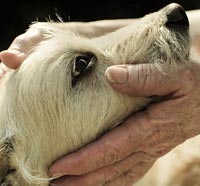5 ways to make sure your pet stays healthy and happy as he ages
by: Dr. Marty Becker
No doubt about it: Puppies are adorable and kittens are certainly cute. But to me, nothing symbolizes deep, loyal love better than a gray-muzzled dog playing a slowed-down game of fetch or a clouded-eye cat nimbly navigating onto a lap and launching into a purr serenade.
See also: 7 ways to save on pet care.

Older dogs should get veterinary checkups twice a year. — Tamzin Roberts/Getty Images
About 45 million dogs and cats — roughly 25 percent of the pet population — have reached senior status. And as they age, their metabolisms slow down and bone densities decrease. But thanks to advances in veterinary medicine — especially in treating pain and in administering anesthesia — senior pets diagnosed with arthritis, urinary incontinence and even cancer are getting a fighting chance at high-quality lives.
Here are some ways you can make the senior years happy and comfortable for your pet:
- Give 'em a nice place to nap. Older pets spend more time snoozing — up to 16 hours a day. Treat them to cushioned, egg-crate-type padded beds and pet-safe heating elements to soothe their arthritic joints, especially during cold months.
- Don't be fooled by food labels. There is no legal meaning for "senior" formula pet food — it is a marketing term. Instead, work closely with your veterinarian to select food that matches your aging pet's activity level, breed and health condition. For example, some couch-lounging senior dogs need foods high in fiber and low in calorie density to cope with their slowing metabolisms. Some senior cats may be contending with brain changes that lessen their appetite. Re-spark their interest at meal time by warming their food in the microwave for a few seconds to release the aroma and or add salt-free chicken broth to their dry food.
- Reconsider your pet-proofing. A decade or more ago, you carefully took steps to make your home safe for your curious puppy or kitten. Now, it's time to re-evaluate your home. Place carpet runners down on tile and other smooth surfaces to provide traction and prevent slippage when you older dog or cat get gets up and walks or runs. Keep a night light on to help pets with fuzzy eyesight navigate better and provide geriatric cats with low-level litter boxes on each level of your home for easy access. Position a sturdy ramp to make it easier for them to access your bed or sofa.
- Book twice-a-year senior examinations. In the final stages of life, a lot can happen to a dog or cat in six months and go undetected without regular veterinary care. I advocate super-senior physicals that include head-to-tail exam, blood screen, urinalysis, fecal exam, X-rays and if warranted, an ultrasound. These age-related exams aid your veterinarian in catching conditions possibly at the onset when they can be better treated and often at a financial savings to you.
- Teach an old dog — and an old cat — new tricks. Provide your senior pet with environmental enrichments to make their life more fulfilling. Introduce your old dog to new places to explore to keep his mind active. Tap into the hunter in your aging cat by replacing the food bowl occasionally with a food puzzle. You never want to stop learning and neither do your pets.
No comments:
Post a Comment